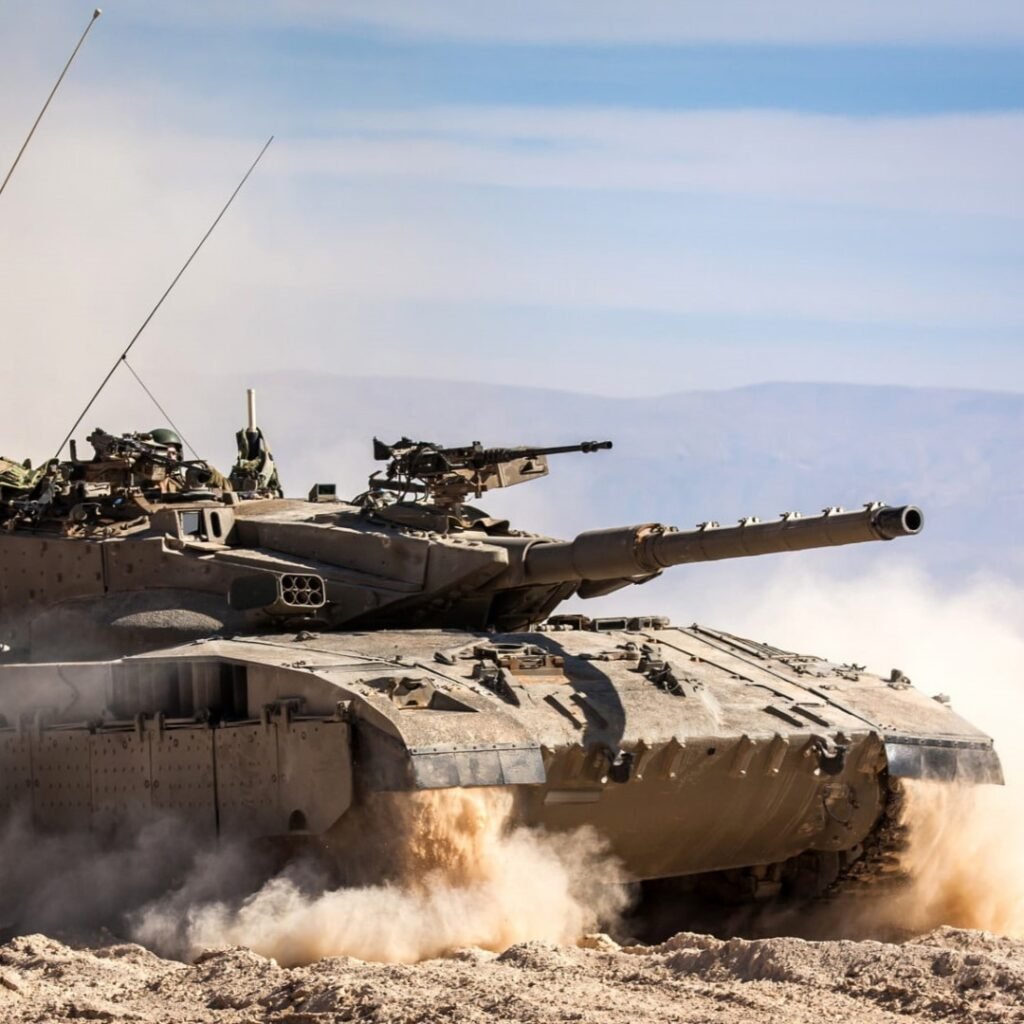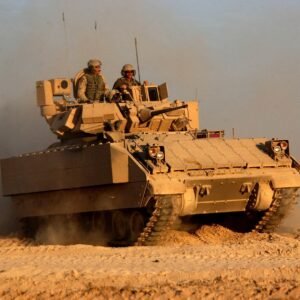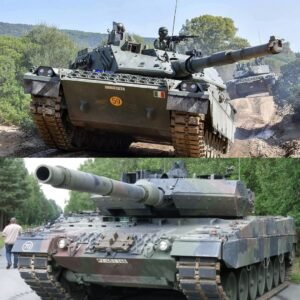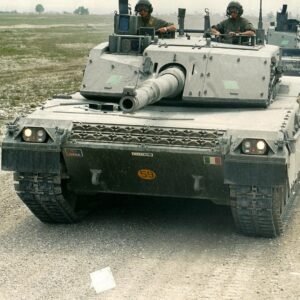I. Introduction
The Merkava Main Battle Tank, the name “Merkava” means “chariot” in Hebrew, and it was chosen as a nod to the biblical chariots that were used in ancient Israel. The tank was designed to prioritize crew safety and survivability, which was a significant departure from the traditional approach to tank design that prioritized offensive capabilities over crew protection.

II. Design and Development of The Merkava Main Battle Tank
The design and development of the Merkava main battle tank were led by the Israeli Ministry of Defense and the Israeli Military Industries (IMI) in the late 1970s. The tank was specifically designed to meet the needs of the Israeli Defense Forces (IDF) and the unique challenges of the region.
One of the key design features of the Merkava is its front-engine layout, which places the engine at the front of the tank instead of the rear, as is the case with most other tanks. This layout provides increased protection for the crew in the event of an attack, as the engine acts as a shield between the crew and the enemy. It also allows for easier access to the engine for maintenance and repair.
The Merkava is also equipped with advanced armor, including composite armor panels and reinforced turret armor, providing excellent protection against both kinetic and explosive threats. The tank’s fire-control system includes a laser rangefinder, a ballistic computer, and a thermal imaging camera, which provides excellent situational awareness and accuracy during combat.
In addition to the tank’s physical design, the development of the Merkava also involved a focus on crew safety and survivability. The tank includes features such as an escape hatch and an automatic fire suppression system to protect the crew in the event of a catastrophic hit.

The development of the Merkava involved extensive testing and evaluation, including combat testing in a range of operations, such as the first Lebanon War, the Gulf War, and the more recent conflicts with Hezbollah and Hamas. The tank has undergone numerous upgrades and improvements since its introduction into service, and it remains one of the most advanced and effective tanks in the world today.
III. The Merkava Main Battle Tank Feature and Capabilities
- Crew Safety: Merkava places a high priority on crew safety and survivability. Its front-engine design provides excellent protection for the crew, and the tank also includes an escape hatch and an automatic fire suppression system.
- Modular Design: Merkava’s modular design allows it to be configured for different combat roles, making it a highly versatile and adaptable tank.
- Armament: The Merkava is armed with a 120mm smoothbore gun, a coaxial machine gun, and a roof-mounted machine gun. Its fire-control system includes a laser rangefinder, a ballistic computer, and a thermal imaging camera, providing excellent accuracy and situational awareness during combat.
- Armor: The Merkava is equipped with advanced armor, including composite armor panels and reinforced turret armor, providing excellent protection against both kinetic and explosive threats.
- Mobility: The Merkava has excellent mobility, thanks to its powerful engine and advanced suspension system. It can reach speeds of up to 64 km/h and has a range of up to 500 km.
IV. The Merkava Main Battle Tank General Specification, Avionics, and Armaments
A. General Specification of The Merkava Main Battle Tank
| Specifications | Details |
| Weight | 65 tons |
| Length (gun forward) | 9.04 meters |
| Width | 3.72 meters |
| Height | 2.66 meters |
| Crew | 4 (commander, gunner, loader, driver) |
| Armor | Advanced composite armor |
| Engine | 1,500 horsepower turbocharged diesel |
| Maximum Speed | 64 km/h |
| Range | 500 kilometers |
B. Merkava Main Battle Tank:- Avionics
- Fire-Control System: Merkava’s fire-control system includes a laser rangefinder, a ballistic computer, and a thermal imaging camera, which provide excellent accuracy and situational awareness during combat.
- Navigation System: The tank is equipped with a sophisticated navigation system that includes GPS, an inertial navigation system, and a digital map display.
- Communication Systems: The Merkava is equipped with a range of communication systems, including secure radio systems and data links, allowing it to communicate effectively with other tanks and ground forces.
- Electronic Warfare Systems: The Merkava is equipped with advanced electronic warfare systems, including jamming devices and sensors, allowing it to disrupt enemy communications and detect incoming threats.
- Sensor Systems: The tank also features a range of sensor systems, including infrared sensors and night vision systems, which provide excellent situational awareness during both day and night operations.
- Targeting Systems: The Merkava includes advanced targeting systems, such as a laser designator, which allow it to accurately engage targets from long ranges.

C. Merkava Main Battle Tank:- Armaments
The Merkava main battle tank is armed with a variety of weapons to engage both ground and aerial targets. Here are the primary armaments of the Merkava Mark IV, the most current version of the tank:
- Main Gun: The Merkava is equipped with a 120mm smoothbore gun, which can fire a range of different rounds, including high-explosive anti-tank (HEAT), armor-piercing fin-stabilized discarding sabot (APFSDS), and high-explosive fragmentation (HE-FRAG) rounds. The gun is stabilized and fitted with a thermal sleeve, which helps to reduce barrel wear and improve accuracy.
- Coaxial Machine Gun: The tank is also equipped with a 7.62mm coaxial machine gun, which is mounted parallel to the main gun and controlled by the gunner. This weapon is primarily used for engaging infantry and other soft targets.
- Roof-Mounted Machine Gun: The Merkava has a 12.7mm machine gun mounted on the roof of the tank, which is controlled by the commander. This weapon is primarily used for engaging aerial targets, such as helicopters and drones.
- Smoke Grenade Launchers: The tank is also equipped with a number of smoke grenade launchers, which can be used to provide cover and concealment during combat operations.
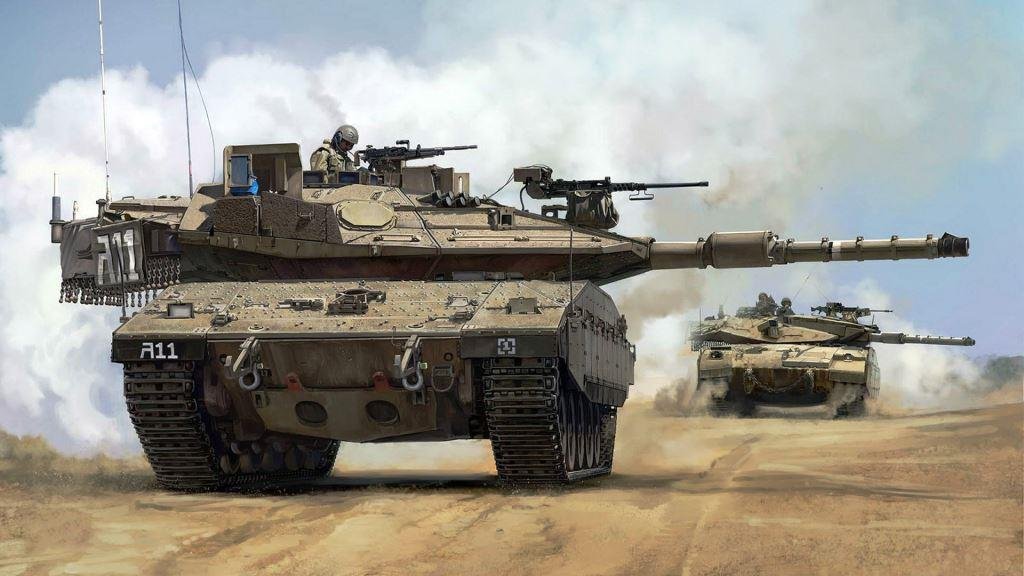
V. The Merkava Main Battle Tank Operational History
The Merkava main battle tank has seen significant operational history, primarily in the Israeli Defense Forces (IDF).
- 1982 Lebanon War: The Merkava Mark I was used extensively during the 1982 Lebanon War, where it proved to be highly effective in urban combat and other challenging terrains. However, it also suffered losses to enemy anti-tank weapons.
- 2006 Lebanon War: The Merkava Mark IV was used in the 2006 Lebanon War, where it was again highly effective in urban combat and other challenging terrains. However, the tank also suffered significant losses to anti-tank weapons, leading to a redesign of the tank’s armor for improved protection.
- Gaza Conflict: The Merkava has been used in several conflicts in the Gaza Strip, including Operation Cast Lead in 2008-2009 and Operation Protective Edge in 2014. In these conflicts, the tank has proven highly effective in engaging enemy fighters and protecting IDF troops.
VI. Prototypes
Before the Merkava main battle tank entered service with the Israeli Defense Forces (IDF), several prototypes were developed and tested.
- “Merkava Aleph” (Mk. I): The first Merkava prototype was developed in the late 1970s and featured a distinctive rear-mounted engine and an innovative design that placed the crew compartment at the front of the tank. The Mk. I also had a 105mm main gun which was designed for improved crew survivability in combat.
- “Merkava Bet” (Mk. II): The Mk. II was an upgraded version of the Mk. I prototype and featured improved armor protection, a more powerful engine, and a new fire-control system. The tank also had a 120mm main gun and an increased ammunition capacity.
- “Merkava Gimel” (Mk. III): The Mk. III was a further upgraded version of the Merkava, with improved armor protection and a new powertrain. The tank also had a redesigned hull and turret for improved ergonomics and crew comfort.
- “Merkava Dalet” (Mk. IV): The Mk. IV is the most current version of the Merkava and features improved armor protection, a more powerful engine, and advanced electronic systems. The tank also has a new active protection system (APS), which is designed to intercept incoming anti-tank missiles and other threats.
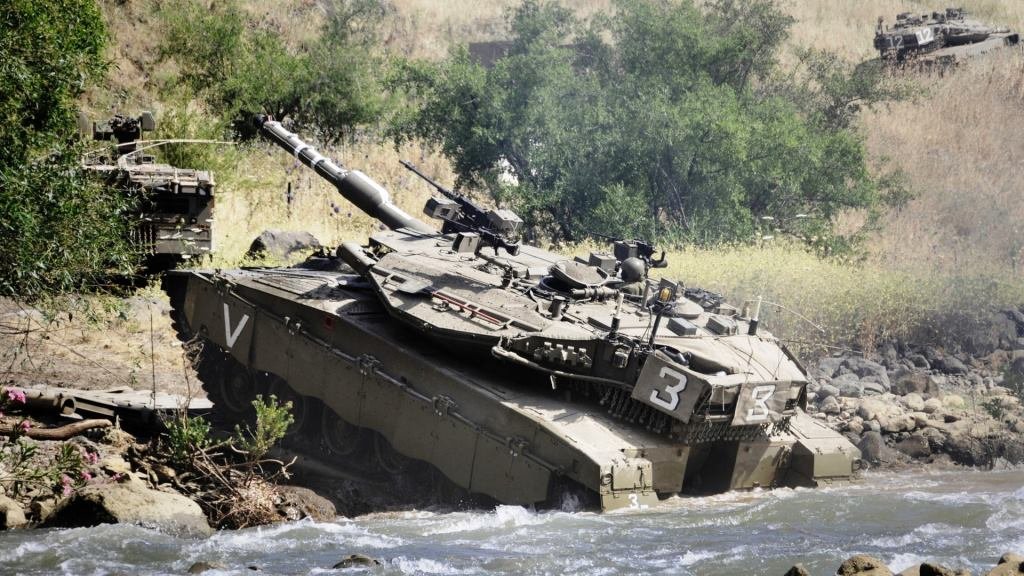
VII. Variants
The Merkava main battle tank has undergone several upgrades and variations over the years, each incorporating improvements in technology, armor protection, and other capabilities.
1. Merkava Mark I:
The first production variant of the Merkava featured a rear-mounted engine and crew compartment at the front of the tank. It had a 105mm main gun and was designed for improved crew survivability.
2. Merkava Mark II:
The second production variant of the Merkava, features improved armor protection, a more powerful engine, and a new fire-control system. It had a 120mm main gun and an increased ammunition capacity.
3. Merkava Mark III:
The third production variant of the Merkava, features improved armor protection, a new powertrain, and a redesigned hull and turret for improved ergonomics and crew comfort. It also had an upgraded fire-control system and a new gun stabilization system.
4. Merkava Mark IV:
The current production variant of the Merkava, features improved armor protection, a more powerful engine, advanced electronic systems, and a new active protection system (APS) for intercepting incoming anti-tank missiles and other threats.
A. Merkava IVm Windbreaker:
An upgraded version of the Merkava IV, featuring additional armor protection and an upgraded APS system.
5. Merkava Mark V “Barak”:- World’s First Fifth Generation Tank
The Merkava Mark 5 “Barak” (Lightning) was recently introduced into service in 2023. This impressive tank comes equipped with some notable enhancements. These include an upgraded Trophy APS for superior protection, a comprehensive 360-degree day and night camera setup that significantly improves the crew’s situational awareness, and a cutting-edge fighter jet-style helmet-mounted display that gives the tank commander an unparalleled vantage point.
Furthermore, the tank is equipped with new sensors that enable it to autonomously identify and swiftly neutralize targets, along with advanced electronic warfare capabilities and highly efficient processing systems. Notably, it also boasts a direct energy system capable of intercepting both drones and cruise missiles, adding an extra layer of defense.
One of the standout features is the incorporation of the Iron Vision helmet-mounted display system, first showcased in July 2018. This system, adapted from the technology used in the F-35 fighter aircraft, utilizes an array of high-resolution cameras strategically placed around the tank to provide the crew members with a comprehensive 360-degree virtual reality view of their surroundings. This significantly enhances their situational awareness, all while ensuring their safety within the tank.
The Barak tank is a new Israeli main battle tank that is considered to be one of the most advanced tanks in the world. It was unveiled in September 2023 and is currently being deployed with the Israeli Defense Forces (IDF).
The Barak features a number of new technologies, including:
- A 360-degree camera system that provides the crew with a panoramic view of their surroundings.
- An artificial intelligence (AI)–powered helmet display that gives the commander real-time information about the battlefield.
- An active protection system that can intercept incoming missiles and rockets.
- A new turret design that is more aerodynamic and provides better protection for the crew.

VIII. Pros and Cons
The main pros and cons of the Merkava main battle tank:
A. Pros:
- Crew safety: Merkava’s innovative design places the crew compartment at the front of the tank, providing improved protection for the crew in combat situations.
- Advanced armor protection: The Merkava features advanced armor protection, including reactive armor and the Trophy active protection system, which provide an additional defense against anti-tank weapons and other threats.
- Powerful armament: The tank’s 120mm smoothbore gun is highly effective against both armored and unarmored targets, and it also has a range of secondary armaments, including a coaxial machine gun and a remote-controlled weapon station.
- Good mobility: The Merkava is highly maneuverable and has good mobility, thanks to its powerful engine and advanced suspension system.
- Versatile: The Merkava can be used in a variety of combat situations, including urban combat, open terrain, and defensive positions.
B. Cons:
- High cost: The Merkava is a relatively expensive tank to produce and maintain, which can make it difficult for some countries to acquire.
- Heavyweight: The tank’s weight can limit its mobility in certain terrain, and can also make it more difficult to transport and deploy.
- Limited export market: Merkava has a relatively limited export market, as most countries prefer to buy tanks from established manufacturers with proven track records.
- Vulnerable to certain threats: While the Merkava’s armor protection is advanced, it can still be vulnerable to certain types of anti-tank weapons, particularly those that use shaped charges.

IX. Comparison of The Merkava vs Abrams
The Merkava and Abrams are two of the most advanced main battle tanks in the world, with both being highly capable and effective in combat situations.
- Design: The Merkava is designed with crew safety as a top priority, placing the crew compartment at the front of the tank for improved protection. The Abrams, on the other hand, has a more traditional design, with the crew compartment located in the center of the tank.
- Armor protection: Both tanks have advanced armor protection, with the Merkava featuring a unique composite armor design and the Abrams using advanced Chobham armor. However, Merkava’s design places a greater emphasis on crew protection, which can make it more effective in certain combat situations.
- Armament: Both tanks have highly effective main guns, with the Merkava’s 120mm smoothbore gun being highly accurate and powerful, while the Abrams’ 120mm gun is highly reliable and effective against a variety of targets. The Abrams also has a more advanced fire-control system.
- Mobility: Both tanks have good mobility, with the Merkava featuring a powerful engine and advanced suspension system, while the Abrams has a highly reliable engine and is known for its speed.
- Cost: The Merkava is generally considered to be more expensive than the Abrams, both in terms of production and maintenance costs.
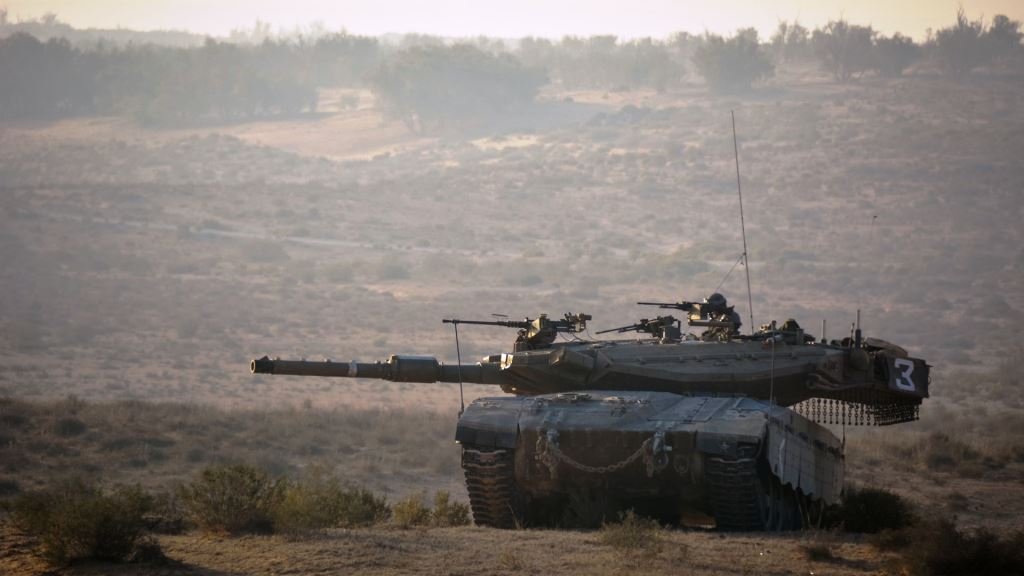

Read More:-Russian T-90 Main Battle Tank and Russian T14 Armata Tank.

